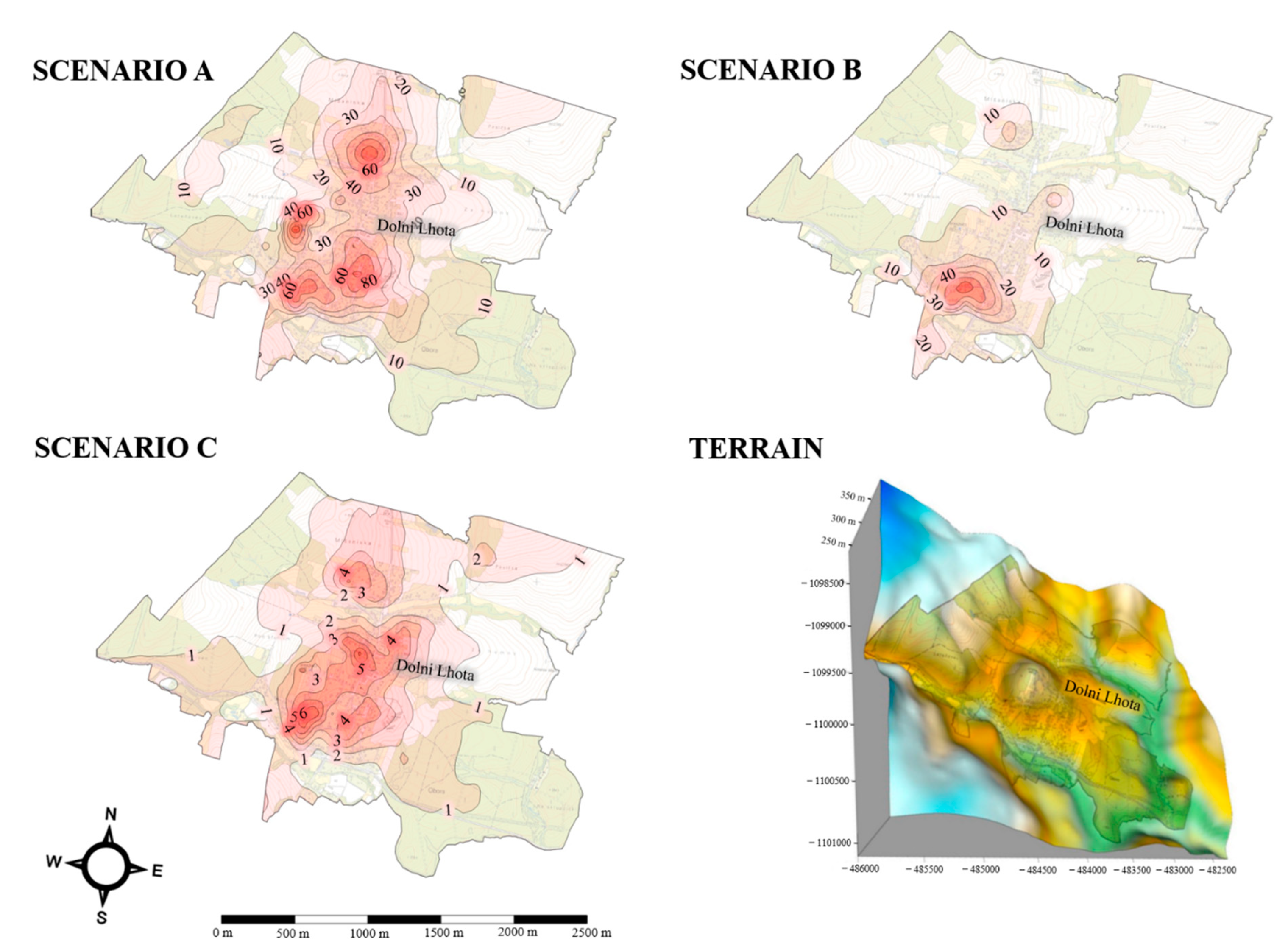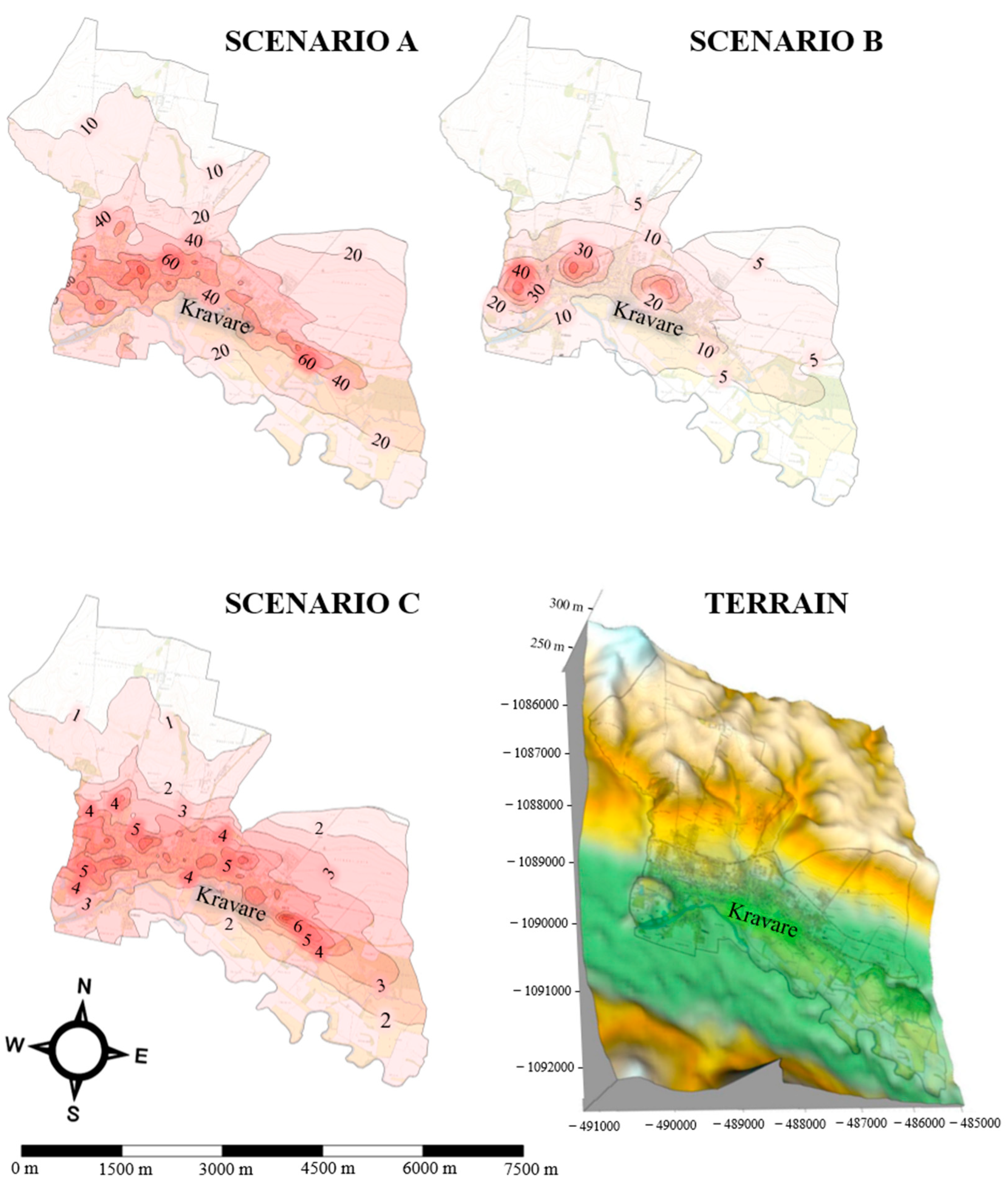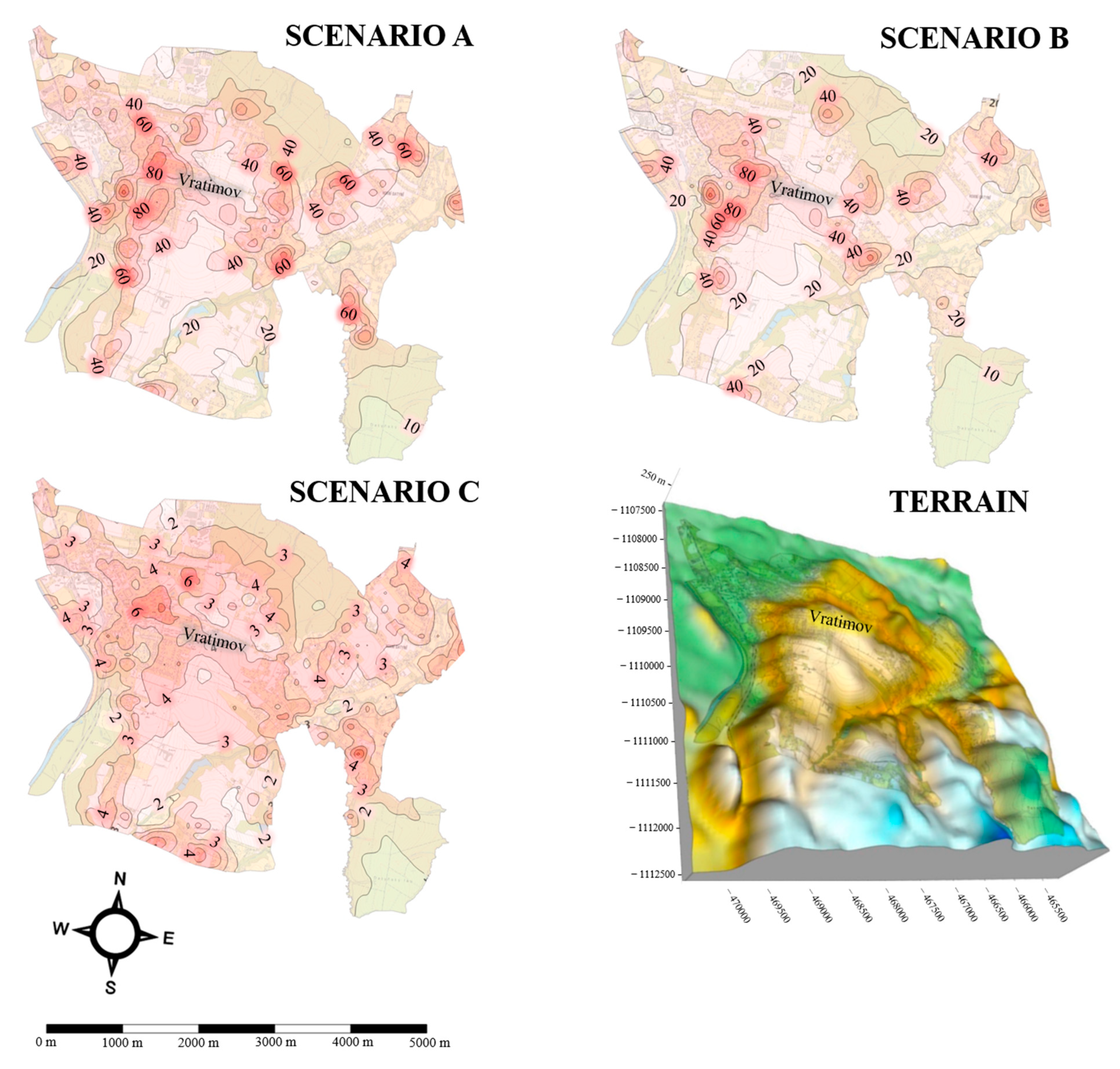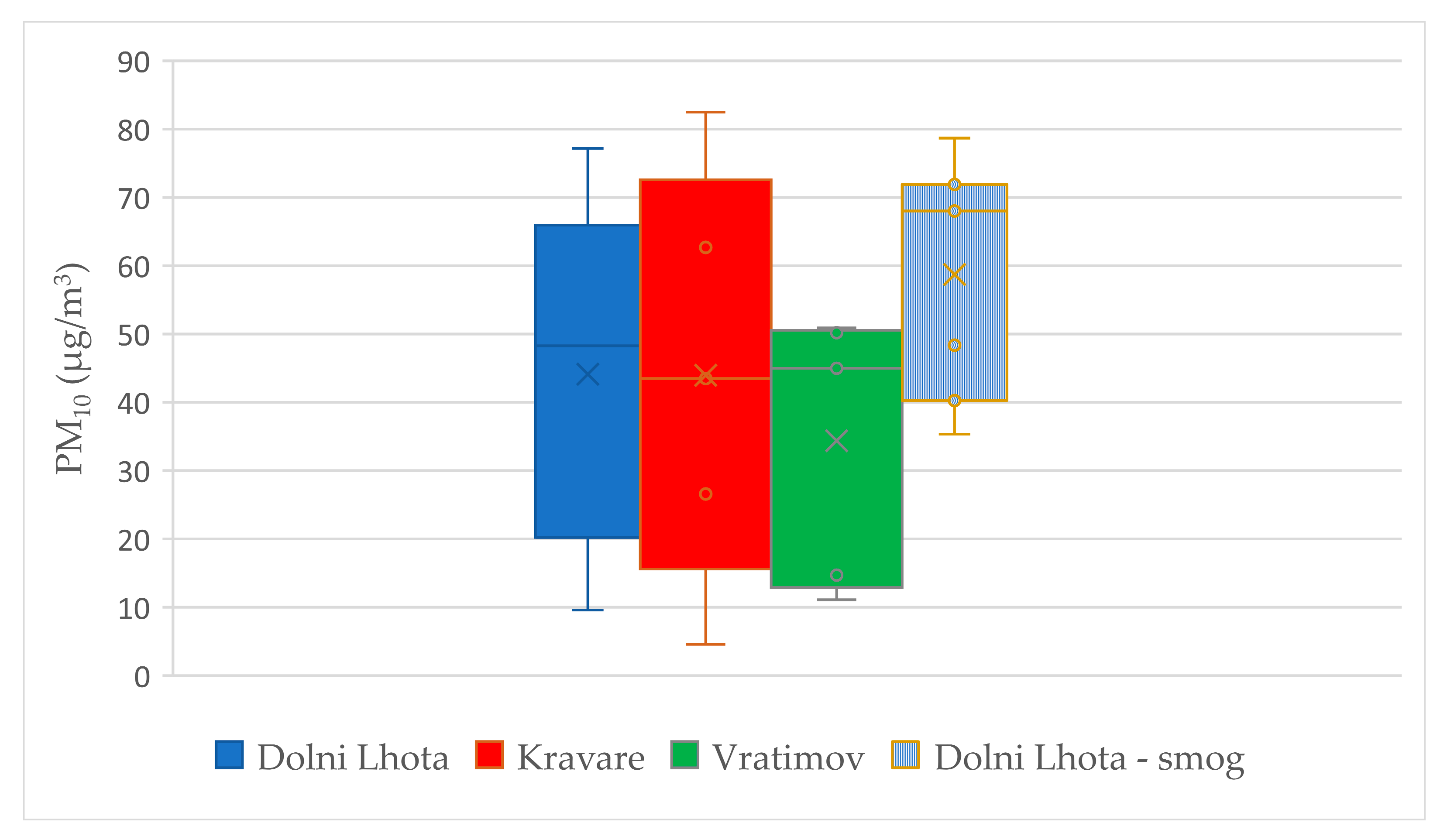The Impact of Solid Fuel Residential Boilers Exchange on Particulate Matter Air Pollution
Abstract
:1. Introduction
2. Materials and Methods
2.1. Locations
- Dolni Lhota (CZ, the coordinates are Lat 49°50′31.776″ N Long 18°5′31.488″ E). This village is located near the city of Ostrava with approximately 1500 residents (area 5.36 km2). It is spread over a hilly terrain, which has a significant impact on the emission stratification during the heating season. There is no heavy industry near the village; local heating and traffic are the main contributors to air pollution. The number of boilers replaced during the “boiler exchange campaign” in the Czech Republic was average in comparison with the other towns in the county (68% of boilers replaced). The number of houses with solid fuel boilers—67 units; the number of replaced solid fuel boilers—46 units.
- Kravare (CZ, the coordinates are Lat 49°55′55.308″ N Long 18°0′17.028″ E). This small town has a population of approximately 6700 residents across an area of 19.37 km2. The terrain around the city is flat. There is no heavy industry near the village; local heating and traffic are the main contributors to air pollution. This town is geographically nearest to the Polish borders from the selected locations. The number of boilers replaced during the “boiler exchange campaign” in the Czech Republic was high in comparison with the other towns in the county (89% of boilers replaced). The number of houses with solid fuel boilers—252 units; the number of replaced solid fuel boilers—225 units.
- Vratimov (CZ, the coordinates are Lat 49°46′11.208″ N Long 18°18′37.944″ E). This town has a population of approximately 7300 residents across an area of 14.14 km2. The topography of the town is characteristic of its undulating relief. There is a large steel plant (Liberty Ostrava), an industrial zone with lighter industries and a highway in close proximity to the city. The number of boilers replaced during the “boiler exchange campaign” in the Czech Republic was quite low in comparison with the other towns in the county (29% of boilers replaced). The number of houses with solid fuel boilers—511 units; the number of replaced solid fuel boilers—148 units.
2.2. Boiler Types
2.3. Dispersion Model Scenarios
2.4. Calculation of Emissions of Particulate Matter (PM)
2.5. Emission Dispersion Model
- Dolni Lhota—total area 10.44 km2; 1178 reference points, out of that 531 points in the urban area and 115 reference points in the rural area.
- Kravare—total area 43.92 km2; 4662 reference points, out of that 263 points in the urban area and 1936 reference points in the rural area.
- Vratimov—total area 26.01 km2; 2809 reference points, out of that 1414 points in the urban area and 501 reference points in the rural area.
3. Results and Discussion
3.1. Dolni Lhota
3.2. Kravare
3.3. Vratimov
4. Conclusions
Author Contributions
Funding
Institutional Review Board Statement
Informed Consent Statement
Data Availability Statement
Conflicts of Interest
References
- Stančin, H.; Mikulčić, H.; Wang, X.; Duić, N. A review on alternative fuels in future energy system. Renew. Sustain. Energy Rev. 2020, 128, 109927. [Google Scholar] [CrossRef]
- Jaworek, A.; Sobczyk, A.T.; Marchewicz, A.; Krupa, A.; Czech, T. Particulate matter emission control from small residential boilers after biomass combustion. A review. Renew. Sustain. Energy Rev. 2021, 137, 110446. [Google Scholar] [CrossRef]
- Lighty, J.A.S.; Veranth, J.M.; Sarofim, A.F. Combustion aerosols: Factors governing their size and composition and implications to human health. J. Air Waste Manag. Assoc. 2000, 50, 1565–1618. [Google Scholar] [CrossRef] [PubMed]
- Růžičková, J.; Kucbel, M.; Raclavská, H.; Švédová, B.; Raclavský, K.; Juchelková, D. Comparison of organic compounds in char and soot from the combustion of biomass in boilers of various emission classes. J. Environ. Manag. 2019, 236, 769–783. [Google Scholar] [CrossRef] [PubMed]
- World Health Organisation. Residential Heating with Wood and Coal: Health Impacts and Policy Options in Europe and North America. Available online: https://www.julkari.fi/bitstream/handle/10024/129716/Chafeetall_.WorldHealthOrganizationRegionalOfficeforEurope.pdf?sequence=1 (accessed on 7 April 2021).
- Křůmal, K.; Mikuška, P.; Horák, J.; Hopan, F.; Krpec, K. Comparison of emissions of gaseous and particulate pollutants from the combustion of biomass and coal in modern and old-type boilers used for residential heating in the Czech Republic, Central Europe. Chemosphere 2019, 229, 51–59. [Google Scholar] [CrossRef]
- European Environment Agency. Air Pollutant Emissions Data Viewer (Gothenburg Protocol, LRTAP Convention) 1990–2018—European Environment Agency. Available online: https://www.eea.europa.eu/data-and-maps/dashboards/air-pollutant-emissions-data-viewer-3 (accessed on 7 April 2021).
- Kucbel, M.; Corsaro, A.; Švédová, B.; Raclavská, H.; Raclavský, K.; Juchelková, D. Temporal and seasonal variations of black carbon in a highly polluted European city: Apportionment of potential sources and the effect of meteorological conditions. J. Environ. Manag. 2017, 203, 1178–1189. [Google Scholar] [CrossRef] [PubMed]
- Naydenova, I.; Sandov, O.; Wesenauer, F.; Laminger, T.; Winter, F. Pollutants formation during single particle combustion of biomass under fluidized bed conditions: An experimental study. Fuel 2020, 278, 117958. [Google Scholar] [CrossRef]
- Byambaa, B.; Yang, L.; Matsuki, A.; Nagato, E.; Gankhuyag, K.; Chuluunpurev, B.; Banzragch, L.; Chonokhuu, S.; Tang, N.; Hayakawa, K. Sources and Characteristics of Polycyclic Aromatic Hydrocarbons in Ambient Total Suspended Particles in Ulaanbaatar City, Mongolia. Int. J. Environ. Res. Public Health 2019, 16, 442. [Google Scholar] [CrossRef] [Green Version]
- UNECE. Protocol to Abate Acidification, Eutrophication and Ground-Level Ozone|UNECE. Available online: https://unece.org/environment-policyair/protocol-abate-acidification-eutrophication-and-ground-level-ozone (accessed on 8 April 2021).
- Han, S.; Kim, J.; Ko, S.H. Advances in air filtration technologies: Structure-based and interaction-based approaches. Mater. Today Adv. 2021, 9, 100134. [Google Scholar] [CrossRef]
- EC. COMMISSION REGULATION (EU) 2015/1189—of 28 April 2015—Implementing Directive 2009/125/EC of the European Parliament and of the Council with Regard to Ecodesign Requirements for Solid Fuel Boilers; European Commission: Brussels, Belgium, 2015. [Google Scholar]
- Lekavičius, V.; Bobinaitė, V.; Galinis, A.; Pažėraitė, A. Distributional impacts of investment subsidies for residential energy technologies. Renew. Sustain. Energy Rev. 2020, 130, 109961. [Google Scholar] [CrossRef]
- Gulliver, J.; Briggs, D. STEMS-Air: A simple GIS-based air pollution dispersion model for city-wide exposure assessment. Sci. Total Environ. 2011, 409, 2419–2429. [Google Scholar] [CrossRef]
- Sáňka, O.; Melymuk, L.; Čupr, P.; Dvorská, A.; Klánová, J. Dispersion modeling of selected PAHs in urban air: A new approach combining dispersion model with GIS and passive air sampling. Atmos. Environ. 2014, 96, 88–95. [Google Scholar] [CrossRef]
- Michanowicz, D.R.; Shmool, J.L.C.; Tunno, B.J.; Tripathy, S.; Gillooly, S.; Kinnee, E.; Clougherty, J.E. A hybrid land use regression/AERMOD model for predicting intra-urban variation in PM2.5. Atmos. Environ. 2016, 131, 307–315. [Google Scholar] [CrossRef]
- Tessum, C.W.; Hill, J.D.; Marshall, J.D. InMAP: A model for air pollution interventions. PLoS ONE 2017, 12. [Google Scholar] [CrossRef] [PubMed]
- Du, X.; Jin, X.; Zucker, N.; Kennedy, R.; Urpelainen, J. Transboundary air pollution from coal-fired power generation. J. Environ. Manag. 2020, 270, 110862. [Google Scholar] [CrossRef] [PubMed]
- Yin, X.; Kang, S.; Rupakheti, M.; de Foy, B.; Li, P.; Yang, J.; Wu, K.; Zhang, Q.; Rupakheti, D. Air pollutants in southwestern China and their transboundary impacts. Geosci. Front. 2021, 12, 101239. [Google Scholar] [CrossRef]
- Hopan, F.; Horak, J.; Krpec, K.; Kubesa, P.; Dej, M.; Laciok, V. Evaluation of the Air Pollution Emissions from the Solid Fuel Heating Boilers in the Czech Households—TZB-Info. Available online: https://vytapeni.tzb-info.cz/vytapime-pevnymi-palivy/15419-bilancovani-emisi-znecistujicich-latek-z-vytapeni-ceskych-domacnosti-tuhymi-palivy (accessed on 25 April 2021). (In Czech).
- Stolarski, M.J.; Warmiński, K.; Krzyżaniak, M.; Olba-Zięty, E.; Stachowicz, P. Energy consumption and heating costs for a detached house over a 12-year period—Renewable fuels versus fossil fuels. Energy 2020, 204, 117952. [Google Scholar] [CrossRef]
- Stolarski, M.J.; Krzyzaniak, M.; Warmiński, K.; Niksa, D. Energy consumption and costs of heating a detached house with wood briquettes in comparison to other fuels. Energy Convers. Manag. 2016, 121, 71–83. [Google Scholar] [CrossRef]
- Bioenergy Europe. Biomass for Heat—Statistical Report 2019; Bioenergy Europe: Brussels, Belgium, 2019. [Google Scholar]
- Karvosenoja, N. Primary Particulate Emissions from Stationary Combustion Processes in Finland; The Finnish Environment Institute (SYKE): Helsinki, Finland, 2001. [Google Scholar]
- Casasso, A.; Capodaglio, P.; Simonetto, F.; Sethi, R. Environmental and economic benefits from the phase-out of residential oil heating: A study from the Aosta Valley region (Italy). Sustainability 2019, 11, 3633. [Google Scholar] [CrossRef] [Green Version]
- Seibert, R.; Nikolova, I.; Volná, V.; Krejčí, B.; Hladký, D. Air Pollution Sources’ Contribution to PM2.5 Concentration in the Northeastern Part of the Czech Republic. Atmosphere 2020, 11, 522. [Google Scholar] [CrossRef]
- Černikovský, L.; Krejčí, B.; Blažek, Z.; Volná, V. Transboundary air-pollution transport in the Czech-Polish border region between the cities of Ostrava and Katowice. Cent. Eur. J. Public Health 2016, 24, S45–S50. [Google Scholar] [CrossRef] [PubMed] [Green Version]
- Godec, R.; Jakovljević, I.; Šega, K.; Čačković, M.; Bešlić, I.; Davila, S.; Pehnec, G. Carbon species in PM10 particle fraction at different monitoring sites. Environ. Pollut. 2016, 216, 700–710. [Google Scholar] [CrossRef] [PubMed]
- Schwarz, J.; Chi, X.; Maenhaut, W.; Civiš, M.; Hovorka, J.; Smolík, J. Elemental and organic carbon in atmospheric aerosols at downtown and suburban sites in Prague. Atmos. Res. 2008, 90, 287–302. [Google Scholar] [CrossRef]
- Błaszczak, B.; Rogula-Kozłowska, W.; Mathews, B.; Juda-Rezler, K.; Klejnowski, K.; Rogula-Kopiec, P. Chemical Compositions of PM2.5 at Two Non-Urban Sites from the Polluted Region in Europe. Aerosol Air Qual. Res. 2016, 16, 2333–2348. [Google Scholar] [CrossRef] [Green Version]
- Public Health Institute Ostrava. Distribution Identification of the Originators of Air Pollution during Good and Bad Weather Conditions; Public Health Institute Ostrava: Ostrava, Czech Republic, 2018. (In Czech) [Google Scholar]






| Location | Boiler Type | Scenario A | Scenario B | Scenario C | ||||||
|---|---|---|---|---|---|---|---|---|---|---|
| Coal | Wood | Total | Coal | Wood | Total | Coal | Wood | Total | ||
| Dolni Lhota | Overfire | 6 | 19 | 24 | 1 | 3 | 4 | 0 | 0 | 0 |
| Gravity feed | 29 | 3 | 33 | 5 | 1 | 6 | 0 | 0 | 0 | |
| Pyrolysis | 0 | 8 | 8 | 0 | 10 | 10 | 0 | 10 | 10 | |
| Automatic | 1 | 1 | 2 | 30 | 17 | 47 | 36 | 21 | 57 | |
| Kravare | Overfire | 21 | 90 | 111 | 3 | 3 | 6 | 0 | 0 | 0 |
| Gravity feed | 111 | 15 | 126 | 5 | 1 | 6 | 0 | 0 | 0 | |
| Pyrolysis | 0 | 7 | 7 | 0 | 7 | 7 | 0 | 7 | 7 | |
| Automatic | 4 | 4 | 8 | 128 | 105 | 233 | 136 | 109 | 245 | |
| Vratimov | Overfire | 42 | 142 | 185 | 21 | 101 | 122 | 0 | 0 | 0 |
| Gravity feed | 225 | 25 | 250 | 150 | 15 | 165 | 0 | 0 | 0 | |
| Pyrolysis | 0 | 59 | 59 | 0 | 59 | 59 | 0 | 59 | 59 | |
| Automatic | 9 | 8 | 17 | 105 | 60 | 165 | 276 | 176 | 452 | |
| Boiler Type | Specific PM Emission | Fuel Consumption | PM Emissions | Max PM Emissions | |||||
|---|---|---|---|---|---|---|---|---|---|
| Lig | Bit | Wood | Coal | Wood | Coal | Wood | Coal | Wood | |
| kg/ton of Burned Fuel | t/Year | kg/Year | g/Hour | ||||||
| Overfire | 24.0 | 8.9 | 1.9 | 10.3 | 11.4 | 215.4 | 21.7 | 179.5 | 18.1 |
| Gravity feed | 4.9 | 7.8 | 1.5 | 7.7 | 10.2 | 42.0 | 15.3 | 35.0 | 12.8 |
| Pyrolysis | - | - | 0.6 | - | 8.6 | - | 5.1 | - | 4.3 |
| Automatic | 0.8 | 1.7 | 0.2 | 6.4 | 8.6 | 6.3 | 1.7 | 5.2 | 1.4 |
| Modelled PM10 (µg/m3) | Measured PM10 (µg/m3) | |||||||
|---|---|---|---|---|---|---|---|---|
| Total Area | Urban Area | |||||||
| Location | Scenario | A | B | C | A | B | C | |
| Dolni Lhota | Min | 3.17 | 1.40 | 0.31 | 6.99 | 1.97 | 0.60 | |
| Avg | 18.01 | 6.92 | 1.45 | 40.81 | 15.72 | 2.86 | 44.13 | |
| Max | 131.18 | 103.21 | 7.83 | 131.18 | 103.21 | 7.83 | ||
| Kravare | Min | 6.50 | 1.02 | 0.61 | 24.03 | 6.36 | 1.87 | |
| Avg | 27.30 | 7.50 | 2.36 | 57.09 | 21.49 | 4.50 | 43.98 | |
| Max | 123.32 | 84.49 | 8.02 | 123.32 | 84.49 | 8.02 | ||
| Vratimov | Min | 7.84 | 4.95 | 0.82 | 14.80 | 10.86 | 1.49 | |
| Avg | 37.70 | 27.30 | 3.14 | 50.72 | 38.24 | 3.90 | 34.38 | |
| Max | 192.12 | 192.12 | 12.29 | 192.12 | 192.12 | 9.42 | ||
Publisher’s Note: MDPI stays neutral with regard to jurisdictional claims in published maps and institutional affiliations. |
© 2021 by the authors. Licensee MDPI, Basel, Switzerland. This article is an open access article distributed under the terms and conditions of the Creative Commons Attribution (CC BY) license (https://creativecommons.org/licenses/by/4.0/).
Share and Cite
Koval, S.; Vytisk, J.; Ruzickova, J.; Raclavska, H.; Skrobankova, H.; Hellebrandova, L. The Impact of Solid Fuel Residential Boilers Exchange on Particulate Matter Air Pollution. Appl. Sci. 2021, 11, 5400. https://doi.org/10.3390/app11125400
Koval S, Vytisk J, Ruzickova J, Raclavska H, Skrobankova H, Hellebrandova L. The Impact of Solid Fuel Residential Boilers Exchange on Particulate Matter Air Pollution. Applied Sciences. 2021; 11(12):5400. https://doi.org/10.3390/app11125400
Chicago/Turabian StyleKoval, Silvie, Jiri Vytisk, Jana Ruzickova, Helena Raclavska, Hana Skrobankova, and Lucie Hellebrandova. 2021. "The Impact of Solid Fuel Residential Boilers Exchange on Particulate Matter Air Pollution" Applied Sciences 11, no. 12: 5400. https://doi.org/10.3390/app11125400







